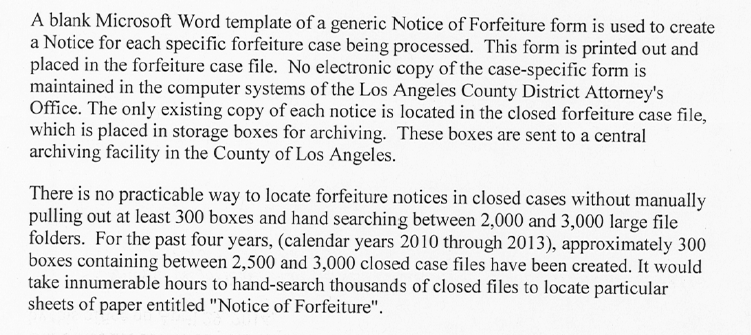It will come, perhaps, as no surprise that MuckRock has not yet exposed gross wrong-doing of the scope documented in the five illustrious investigative series we set out to replicate or expand upon in the Pulitzer Project.
We have, however, made some interesting inroads into the lucrative and understandably controversial bureaucracy of asset forfeiture – inspired by Steve Berry’s and Jeff Brazil’s 1992 series on racial profiling and theft by sheriff’s deputies in Volusia County, Florida.
Following the money
In most jurisdictions, when police conduct a lawful search of a person or their property, officers can seize any money or other physical property they believe to be involved in criminal activity. Usually this involves drugs or guns, but it can extend to assets such as cars, yachts, and houses.
The burden of proof usually lies on the owner, who must demonstrate that their money or goods are not crime-related in order to avoid forfeiture.
If the property is forfeited, its value is split between the law enforcement and prosecutorial agencies involved in the seizure and a general fund for either the state or federal government.
Asset forfeiture is therefore a valuable cash cow for money-hungry law enforcement agencies.
The Los Angeles County Sheriff’s Department, for example, ended the 2013 Fiscal Year with over $12 million in its Equitable Sharing Fund after spending over $11.5 million from that account, including nearly $5 million on a new helicopter.
And that balance only includes the profits from assets the LASD seized with the help of federal law enforcement agencies.
Los Angeles County is supposed to submit data on seizures made by its various law enforcement departments to the California Attorney General each year.
But when MuckRock requested that data for 2010-2013 we received four very different spreadsheets.
In some years, the county didn’t differentiate seizures by the agency that made them; in others it didn’t include the value of the assets seized; and sometimes the county never submitted that data to the attorney general at all.
Determining how often sheriffs’ departments seize assets by themselves, the value of those assets, and especially who they seize the assets from has proved quite challenging.
In a file, in a box, in a warehouse
In 1992, Berry and Brazil found that in at least 90 percent of cases where Volusia County sheriff’s deputies stopped a motorist and seized that person’s money without arresting them, the motorist was either black or Hispanic.
We filed a series of requests to see if there were any similar practices at four sheriff’s departments that had previously been the targets of Department of Justice investigations into civil rights abuses or asset forfeiture practices: Los Angeles County, Calif.; Orange County, Calif.; Alamance County, N.C.; and Jefferson Parish, La.
Berry and Brazil’s initial reporting centered on asset forfeiture files that the Volusia County deputies generated each time they effected a cash seizure, Berry told MuckRock.
“As far as getting the records was concerned, it was pretty easy,” he said. “They had a file folder for every cash seizure that the deputies made out on I-95. They were all closed cases so we asked to see them and they opened up their files to us.”
The two reporters spent weeks reviewing and copying the files, and months tracking down the motorists whose money was seized.
In MuckRock’s effort to replicate their work in different jurisdictions, we identified a key form that the four sheriffs’ departments seemed to use some variation of to document seizures: asset forfeiture notices.
The notices are essentially receipts, created by either the sheriff’s deputies or the district attorney’s office, and they list what assets deputies seized and from who.
Generic incident or arrest reports filed by deputies after each seizure would tell us the races of the property owners.
Here is a blank example of a form that MuckRock received from the LASD that serves as both a receipt and incident report:
So far, pretty straight forward.
But it turns out that even in Los Angeles County – which proved surprisingly helpful and fulfilled all MuckRock’s requests within a week – there are no computerized records of whose property the sheriff’s department has seized.
Instead, seizure receipts are placed in individual case files and then buried in a warehouse somewhere in the county, as the Los Angeles County District Attorney’s office explained in the letter excerpted below.
MuckRock received rejections similar to the one from Los Angeles County from the three other Sheriffs’ departments when we asked for their asset seizure receipts. They all cited the burden fulfilling such a request would place on their employees.
We don’t have it, you can’t have it
Thanks to the Volusia County Sheriff’s Department’s file-keeping practices, and likely the natural charm of the two reporters, Berry and Brazil were able to get their hands on all the department’s asset forfeiture files without sifting through unrelated cases.
“They were all in one place, just rows and rows of file cabinets … where they stored all of the asset forfeiture cases,” Berry said.
The Volusia County Sheriff’s Department’s lack of familiarity with Florida’s already lenient public records law also proved a boon to the two reporters.
In addition to the asset forfeiture files, the department gave Berry and Brazil access to FBI files and other documents it was obligated to withhold.
For MuckRock, the opposite was true. We found it much more helpful when the sheriff’s offices we dealt with understood their states’ records laws. That was not always the case.
The various California agencies we requested documents from fulfilled, or are actively working on, our less burdensome requests. Los Angeles agencies were particularly helpful and the Auditor-Controller’s office even went so far as to provide us with a cheat-sheet for acronyms.
Jefferson Parish agencies, on the other hand, rejected all requests except one for a blank form. That request was only fulfilled after we appealed the rejection twice.
Alamance County proved to be a black hole from which no request ever returned.
For example: The Orange County Sheriff’s Department, when asked for their internal guidelines on asset forfeiture, provided two detailed manuals and examples of the forms their deputies must file when seizing assets.
Alamance County rejected the exact same request, citing several nonsensical exemptions - MuckRock’s request for the manuals was “too broad in scope and did not specifically identify the records.”
Yet the county attorney’s office, which handled the request, was able to identify the records requested well enough to determine that they were “criminal investigative records” and therefore exempt from disclosure.
And finally, the request was rejected on the grounds that Alamance County is not required to create a new document to fulfill a records request.
While MuckRock will continue to request asset forfeiture records, it seems unlikely we will make much progress in tracking down the racial component that led to Berry and Brazil’s Pulitzer prize.
The grand takeaways from this adventure are that asset forfeiture generates a lot of money which is quite hard to track; different departments document seizures in different ways, or perhaps not at all; and if anybody is keen to follow in Berry’s and Brazil’s footsteps, they’re going to need to spend a lot of time in a warehouse.
Image via Wikimedia Commons and is licensed under CC BY 3.0





